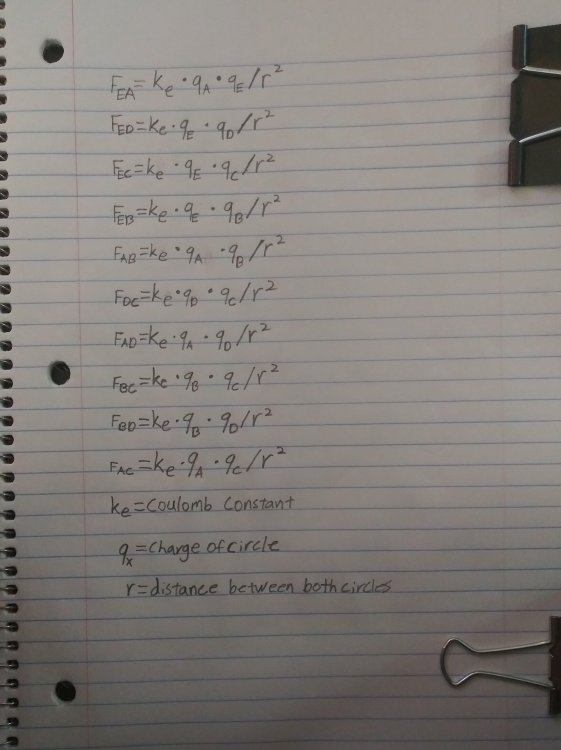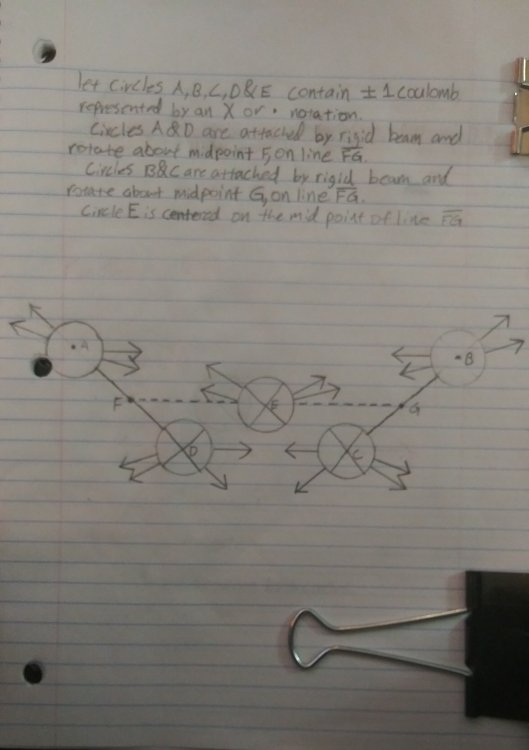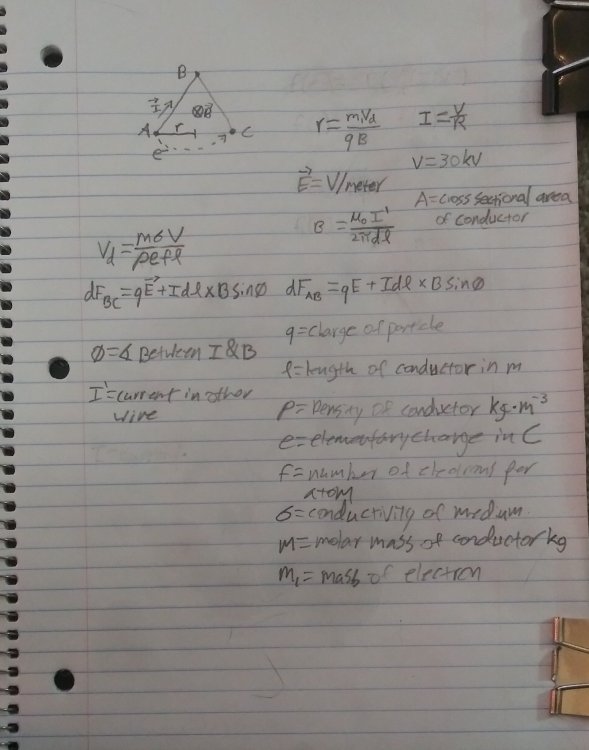

DandelionTheory
Senior Members-
Posts
225 -
Joined
-
Last visited
Content Type
Profiles
Forums
Events
Everything posted by DandelionTheory
-
If you were in space between the bucket ends of 2 water wheels, close enough to put your feet on, and ran up both of them with downward force only, you would pop up above them and they would spin in place. If you jumped but a tether attached to both wheels axis pulled you back, the opposite force would pull them to you. Just run up the wheels again.
-

poles of an electromagnet question
DandelionTheory replied to DandelionTheory's topic in Speculations
Rotation. -

poles of an electromagnet question
DandelionTheory replied to DandelionTheory's topic in Speculations
Can you show me how I would calculate that balance? I'm having trouble finding the right documentation for linear motion on a wheel axle due to different angular torques applied. If you know of anything I would appreciate it. Because I want to know why you came to the conclusion. I just realized I did the statement wrong. Apologies. I'm making a correction to this statement: Should say: Circle E is forced up half the cycle, while no force is experienced by circle E while circle A & B are parallel to line FG. As circles A & B pass line FG to the closest point of rotation to circle E, if circle E were to be manually switched to it's opposite charge it would once again experience force for the remainder of the cycle while circles A, C, B & D rotate -

poles of an electromagnet question
DandelionTheory replied to DandelionTheory's topic in Speculations
The thread states the lorentz force pushes the op current up, later you point out the opposite force on the magnet core. I point out after there might be a significant difference in round vs straight magnetic fields. You wanted a diagram, I did a diagram with coulombs law and mentioned rotation which would imply a time variant. I can do it with current too buddy. Circle E is forced up half the cycle, while no force is experienced by circle E while circle A & C are parallel to line FG. As circles A & C pass line FG, if circle E were to be manually switched to it's opposite charge it would once again experience force for the remainder of the cycle while circles A, C, B & D rotate. Man you know I can't calculate over time yet. I'm still in pre calc -

poles of an electromagnet question
DandelionTheory replied to DandelionTheory's topic in Speculations
Pushing on a hinge. If at the time circle A and circle C reach line FG someone were to manually change circle E to the opposite charge, the momentum of A, B, C and D will carry over to the other side of the cycle. At this time, flip E's charge to continue. -

poles of an electromagnet question
DandelionTheory replied to DandelionTheory's topic in Speculations
I misspoke. This illustrates the idea with pivot points and a Coulomb's law calculation on 5 bodies. Assume line FG is rigid. -

poles of an electromagnet question
DandelionTheory replied to DandelionTheory's topic in Speculations
Compared to one that doesn't. Loops of current will pivot about their axis to align with another magnetic field, which I assume requires energy. Protons rotate about their center axis towards the electric field, while a loop of current rotates about their center axis towards the opposite signed magnetic field. I want to know if equal but opposite forces can be transformed between the electric and magnetic field. -
No. I'm trying to show the the lorentz force pushes all currents from the center of the loop, the Laplace force calculates the physical translation of the wires. If the arc were in a field that accelerated it far beyond the point of return to the cycle, that mass ejection would add to the force on the wires in the opposite direction. Mass ejection is a symptom of operation at high particle velocity.
-
I'll be more specific. Due to mass not leaving the system, just the wires (it comes back), I never added it to the net force on the wires. I admit it's not thorough. I did use it as an explanation to how it works because it's not attached to a wire, it ejects the charged mass outside the wires to lose the drag coefficient of the Laplace force on the wires. My idea came fromI a rail gun: the rails, slug, and back end make a current loop that induce the Laplace force on each current. The force is equal and opposite in each direction away from the center of the current loop. So if the slug is an arc of current, any charge carriers accelerated too far to return to the system would be lost mass and energy. I'm attempting to show the resultant Laplace force on the wires due to the current loop seems to favor one side. But the issue I'm having (I assume) involves calculating the possible position of the electron during the "cycle" so I can better clarify the magnitude of the Laplace force on the wires from the arc.
-

poles of an electromagnet question
DandelionTheory replied to DandelionTheory's topic in Speculations
Thank you. I'm having trouble finding sources to address this specifically. A problem I run into is most people that explain magnetic field interaction attempt to translate them into moving currents. While it's a novel idea and proved to work, I think it misses the point with the difference between them being round and or straight. A loop of current has a pivot point in the center and not centered at the current itself, I'm attempting to see if it makes a difference. -

poles of an electromagnet question
DandelionTheory replied to DandelionTheory's topic in Speculations
Gotcha. Is there a different interaction between straight magnetic fields and round ones than 2 round ones? -
Thank you I'll work on it. I wonder if you're considering the angle of interaction. It's set up to eject electrons downward-ish and receive them as they come up. The magnetic fields from the wires are meant to curl the arc so the mass to mass interactions are angled vertically.
-

poles of an electromagnet question
DandelionTheory replied to DandelionTheory's topic in Speculations
Thank you. You pointed out my claim better than I did. I have another inquiry; Does the initial angle of interaction between the current and the core's magnetic field affect the magnitude of the interaction due to it being 3 bodies of interaction? Ie if the angle between the poles was 10° but the B vector adds to 0°, does it change the magnitude of the interaction? -
Thank you, can you show me an example of that force? Thank you. Force on the arc from the wires and vice versa? Agreed. I thought it had to do with current phase (like a cavity magnetron but this is represented as a DC "wiggle" ) and assumed it required integration to calculate potential path of the electron while in the arc. Which I mentioned needing help with. (Again I assumed it was part of the answer) If a wire is placed between points A and C, I can use it as a maximum value to derive the affect of a straight arc on the wires. I am still working out a minimum approximation. Hrm, mass ejecting mass is a reaction, while mass colliding with mass is another reaction. I'm assuming this satisfies your inquiry.
-
Does this mean arc's cannot form naturally or the opposite force of an electron leaving a wire attracts it back? The electric field is constant in the example until the end of the cycle. Between points A and C (Which is not shown) Please be specific.
-
Youre assuming I mean all the electrons in a wire leave and this is some magic thing. No. Assume point A is battery negative and point C is battery positive. Also assume more than enough energy is in the systems battery for thousands of "cycles"( I didn't calculate for time yet) Do you assume this force exceeds the force on each wire?
-

poles of an electromagnet question
DandelionTheory replied to DandelionTheory's topic in Speculations
Yes I know, observe the uniformity of the B fields and apply. The lorentz force has a sin theta variable, while the rail gun calculation involves 3 conductors with uniform fields some variables cancel. It also assumes you understand the right hand rule. It slides. Does it matter though? because the reaction on the core would be opposite ( net force down). I guess seeing as the blue cable can move and since it's obviously less dense than the core, it would move up. (Assuming) It is exactly opposite forces in direction and magnitude. -
Lines AB and BC are wires connected at point B and have an air gap between points A and C of 1inch with a potential difference of 30kv. While electrons arc between points A and C they experience the lorentz force and have a curved path due to the magnetic fields of the current in the wires. So the curved path with radius r needs a few things: The curve of electrons from point A to point C can be found by solving for r, which is dependent on the magnitude of the magnetic field from the current in the wires AB and BC. An arc's current increases exponentially with time and therefore the current in the system will increase while an arc is in place, and therefore r will increase. I do not know off hand how to calculate over time, I am aware r will change as current increases. I'm having trouble solving drift velocity of the electrons arcing between points A and C not in a wire, if anyone can point me to the right place to look I would appreciate it.
-
Give me a minute, I'll draw a picture with maths!
-

poles of an electromagnet question
DandelionTheory replied to DandelionTheory's topic in Speculations
I see you think it's contradictory. I was making a point on his character not what he was saying. I never asserted anything other than a force on a current in a direction. I didn't make assertions I had a solution. I did not claim this idea violated any law, nor does it violate any known ones. Because I mentioned a belief of another person I was moved? Lame. -

poles of an electromagnet question
DandelionTheory replied to DandelionTheory's topic in Speculations
I didn't put it here. It was moved. I made statements with math and it was still moved to speculation. For an op to ask questions about physics in a classical physics forum is not off base, but to assume any point being made is base for the whole post to be sent to speculation... Best move. I don't know what the forum is for if not to ask questions, and for any point to be assumed speculation isn't a forum it's gatekeeping. Thank you. Please allow me to aggregate the needed variables. -
The difference between the Laplace force and the Lorentz force is the electron is physically in the wire with the Laplace force and does drag on the wire where with the lorentz force the charge carrier is free and is a calculation on the charge carrier itself no wire. If an electron is not in a wire it cannot contribute to the drag on the wire in the Laplace calculation. Once it is out of the wire it's a free charge carrier susceptible to all normal forces with no drag on the wire. Because it's not in the wire.



